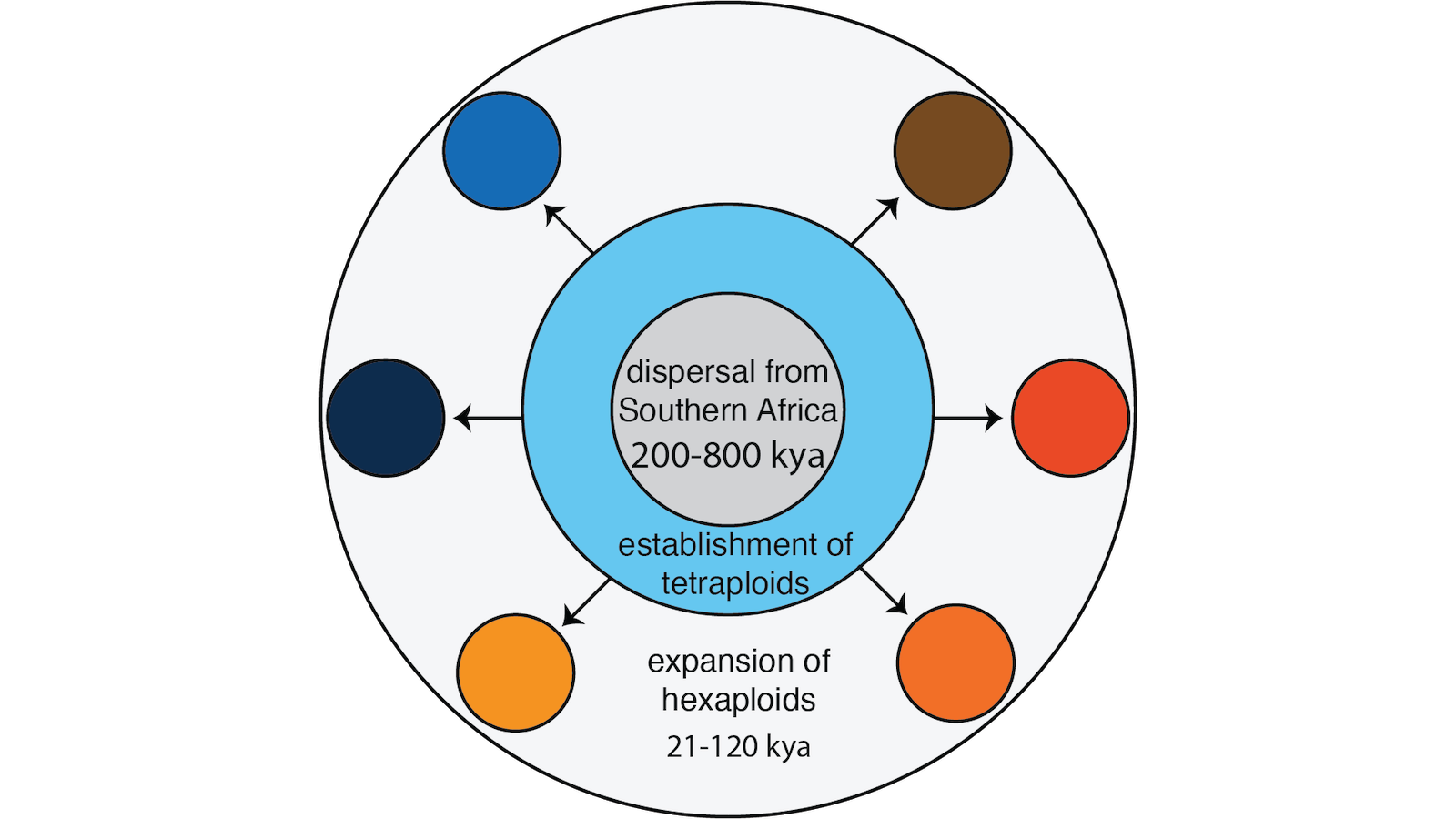The Natural History of Madagascar
population genetic and ecological processes interact to generate high species richness in constrained geographic areas
Anthropogenic ecosystem change
Investigating the origins and pre-human extent of Madagascar’s grasslands is part of a long-term project that contributes to a much broader effort to understand the factors that determine where tropical grassy biomes occur and do not occur 1. Field work began in March 2022 where genomic data will was used to estimate changes in population size over time in ecologically important grass species. Anticipated outputs will contribute to productive dialogs on land management and conservation policy. Initial analyses have suggested a model of Paleoclimatic grassland expansion and a role for polyploidy underlying niche diversification during Pleistocene climate change. Results are thus far in agreement with previous pilot analyses 2 and previous animal studies 3. Field work will continue in March of 2026 to search for dipload Loudetia simplex and establish new systems.

Model of Loudetia simplex colonization and expansion in Madagascar It remains unclear if diploids were ever present in Madagascar or if they went extinct, but recent Pleistocene expansions seem to accompany an increase in ploidy
.
Integrative evolutionary biology
The lab often works across disciplines and organismal groups including animals to reconstruct the evolutionary history of communities and ecosystems. Past efforts have focused on lemurs 4, but future directions will integrate zebu cattle with grassland research.
-
Phelps LN, Razanatsoa E, Davis DS, Hackel J, Rasolondrainy T, Tiley GP, Burney D, Cox R, Godfrey L, Hempson GP, Hixon S, Andermann T, Andriambololonera S, Andriamiarisoa LR, Antonelli A, Besnard G, Birkinshaw C, Bond W, Chikhi L, Fernández-Garcia V, Gillson L, Haberle S, Hansford J, Joseph GS, Kull CA, Mangut CL, Marchant R, Montade V, Pham KV, Rabehevitra D, Radespiel U, Raharimampionano J, Rajaonah T, Rakotomalala, Ramiadantsoa T, Ramiandrisoa BA, Ranarijaona HLT, Randriamboavonjy T, Randrianarimanana F, Randriatsara F, Ratsirarson J, Razafimanantsoa AHI, Salmona J, Samonds K, Scroxton N, Seymour C, Steffens TS, Teixeira H, Voarintsoa NRG, Waeber PO, Wilmé L, Yoder AD, Fisher EC, Solofondranohatra C, van Elst T, Crowley B, Douglass K, Vorontsova MS, Lehmann CER. 2025. Advancing transdisciplinary research on Madagascar’s grassy biomes to support resilience in ecosystems and livelihoods. Ecological Monographs 95:e70011. doi: https://doi.org/10.1002/ecm.70011 ↩
-
Tiley GP, Crowl AA, Almary TOM, Luke WRQ, Solofondranohatra CL, Besnard G, Lehmann CER, Yoder AD, Vorontsova MS. 2023. Genetic variation in Loudetia simplex supports the presence of ancient grasslands in Madagascar. Plants People Planet 6:315-329 ↩
-
Tiley GP†, van Elst T†, Teixeira H, Schüßler D, Salmona J, Blanco MB, Ralison JM, Randrianambinina B, Rasoloarison RM, Stahlke AR, Hohenlohe PA, Chikhi L, Louis Jr EE, Radespiel U, Yoder AD. 2022. Phylogeographic analysis of Goodman’s mouse lemur reveals historical interconnectivity of Madagascar’s Central Highlands and eastern rainforests. Molecular Ecology 31:4901-4918. ↩
-
van Elst T, Sgarlata GM, Schüßler D, Tiley GP, Poelstra JW, Scheumann M, Blanco MB, Aleixo-Pais IG, Rina Evasoa M, Ganzhorn JU, Goodman SM, Hasiniaina AF, Hending D, Hohenlohe PA, Ibouroi MT, Iribar A, Jan F, Kappeler PM, Le Pors B, Manzi S, Olivieri G, Rakotonanahary AN, Rakotondranary SJ, Rakotondravony R, Ralison JM, Ranaivoarisoa JF, Randrianambinina B, Rasoloarison RM, Rasoloharijaona S, Rasolondraibe E, Teixeira H, Zaonarivelo JR, Louis EE, Yoder AD, Chikhi L, Radespiel U, Salmona J. 2024. Integrative taxonomy clarifies the evolution of a cryptic primate clade. Nature Ecology & Evolution doi: https://doi.org/10.1038/s41559-024-02547-w. ↩